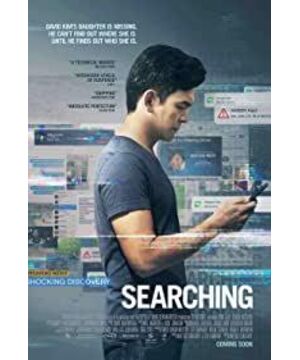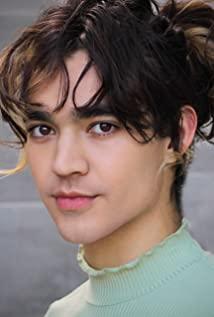I haven't been to the cinema for a long time. Yesterday I went to see the sneak preview on Tuesday night as usual. I felt I had a pleasant surprise. Generally speaking, it is a good film that is worth the price, and when you look closely at it in terms of plot, rhythm, technological innovation, actor performance, lens language, etc., there are also remarkable points. As for friends who care about whether this film is scary or not, I can answer responsibly. This film is rated for 12 years or older in Germany. There are no violent and bloody ghosts and murders in the film, so timid friends can rest assured. Watch.
Since this is a mystery film, this article will not analyze the plot of the story specifically to avoid spoilers.
Innovation in visual presentation
I like to introduce the movie Searching like this: it is a very typical thriller, but it is presented in a very atypical way.
----Aneesh Chaganty, at LAAPFF2018 【1】
Director Aneesh Chaganty introduced his first feature film in an interview at the 2018 Los Angeles Asia Pacific Film Festival. I say "very atypical" because this is a movie that is presented on a computer screen from beginning to end. In other words, the screen that the audience faces is like their own computer desktop, and all the plots are transmitted through the changes that occur on the screen. This film won the "Next Generation Audience Award" at the 2018 Sundance Film Festival. It is highly praised for its bold and innovative visual expressions in the film. It is the first film that has long been inseparable from our lives. Open electronic equipment and technology products to pick the mainstay of the movie.
However, if you put aside the limitations of the big screen, Aneesh Chaganty is not the first person to eat crabs. As early as the beginning of 2015, the phenomenon-level hit American drama "Modern Family" had already tried this way of visual expression in the sixth season. The sixteenth episode of the sixth season titled "Connection Lost" tells a hilarious story entirely on the computer screen. The daughter’s mobile phone shut down caused her mother on a business trip to be nervous. She used iMessage and FaceTime to contact her family and relatives one by one, and tried to hack into her daughter’s Facebook account to obtain her daughter’s social information, which led to a series of laughable misunderstandings. . Restricted by the warm comedy positioning of the play and the duration of about 20 minutes, such a unique episode did not have much play in the atmosphere and suspense creation, but it still got a high score of 9.5 on IMDb, which was regarded by many fans as " Favorite episode of "Modern Family". Although the main creator of Searching did not mention the jewels of "Modern Family" at the film festival and interviews, it is not difficult for the audience to find some similarities when they use the computer screen as a medium. This is not to talk about the reference relationship between them, but to point out that this attempt to use new media in film language is not a flash of inspiration, but requires careful observation and careful experience from daily life. , And only then can the experience of using these technological products be transformed into elements of film narrative one by one. In other words, if the audience does not have the daily experience of using these products, then some of the details that the creators have worked so hard to design that are knowingly or terrifyingly can be easily overlooked. Or, if the audience is a group of people whose grandparents rarely use smartphones, social media, or laptops, then they may not really understand what happened.
For example, when typing in a chat dialog box, the other party sent a new message before typing a sentence, so he deleted the sentence that was just typed and retyped the sentence; this sentence is still Without sending it, the other party sent another one first, so he deleted and retyped; after repeated several times, he finally sent a concluding reply. Or, when you are very angry or very excited, a long message full of emotions, tens or hundreds of words, is typed quickly, but after thinking about it, it feels wrong, and you delete one word after another. For another example, video chatting with your mother, she has been nagging about the small problems and bad habits in your life. You listened absent-mindedly while opening a certain treasure's webpage. Suddenly your mother asked, "It looks like your eyes What are you going to see?" You are so scared that you quickly turn your eyes away from a certain treasure and repeatedly deny "I didn't see anything!" It is these details of life that can make the story come to life in the narrative of the movie, which makes you feel uncomfortable. Letter, let the audience resonate. However, for the creators of Searching, how to present them on the computer screen is the main problem they face.
Debra Messing, who plays the female police officer, said in the interview that she felt dry when she read the script for the first time. The descriptions of "mouse cursor moved from left to right" made her feel weird. However, After the director showed her a Google search engine commercial, she was amazed that she could really make a story like this. [2] Director Aneesh Chaganty also mentioned this ad titled "Parisian Love" many times in different interviews, which roughly means to show that the hero uses Google to search for different content to describe him and a The story of Paris girls falling in love. This commercial produced by Google in 2010 is really dry compared to the later Searching movie, because the audience only sees constantly changing Google search items and results. But its creativity is so powerful that it made people feel like opening the door to a new world at the time. Because it takes the essence of film language since the advent of montage technology to the extreme, this essence is the brain supplement of the audience. When we see "church" in Google search entries, we automatically make up for the male and female protagonists to get married, see "crib" to make up for them to have children, and so on. So much so that the director Aneesh Chaganty said a very high evaluation. He said that he only felt "Wow" after watching this ad. He found that he knew a new language, and he didn't even know that he had controlled it before. The language is the language of technology and how we use network tools every day. 【3】
Whether it’s the Google commercial, the sixteenth episode of "Modern Family", or the movie Searching, this kind of visual presentation innovation has a clear direction, which is to change the way technology products are used in movies. way of participation. In the past, we saw characters using computers and mobile phones on the screen. Later, we often saw text messages with prompt sounds displayed next to the characters in the form of dialog boxes in film and television dramas, or occasionally filled the entire screen with computer screens. Picture frames to guide the audience's gaze and perspective. The creators of Searching are trying to make those technological products that are becoming more and more important in our lives participate in the narrative of the film in a more interactive and profound way. Behind this participation is not only because we use technology products and social media more and more frequently, but also because their appearance and development have gradually changed our own way of existence. To use science fiction terms, we are all in Unknowingly become a cyborg (cyborg). Of course, this kind of electronic life should have a more electronic visual presentation. Although the audience may not have seen such a movie before, everyone is familiar with and understands this kind of picture, so this kind of visual presentation innovation There should be no obstacles on the receiving side. This is like a child watching a cartoon for the first time who can accept the use of montage without any obstacles, and can understand the broken time and the coherent story behind the picture. Interestingly, 3D movies have become popular in recent years. More and more investors and filmmakers are working hard to expand the fidelity of CG special effects and three-dimensional visual effects. Perhaps they would not think of Searching as an attempt to return to two-dimensionality to the audience. Psychologically, the real sense of substitution is no less than the visual effect of the realistic 3D scene.
Use of film language
If the appealing gimmick of Searching's movie is "occurring on the computer screen from beginning to end", then it can win the audience's recognition by the successful use of the language of the movie. The main creators have expressed in various interviews that in order to turn this innovative idea into a movie, their shooting and production process is to cross the river by feeling the stones, because there are too many problems to find a solution from the existing experience, only Can move forward while groping. For example, Debra Messing, who plays the female police officer, and John Cho, who plays his father, have the most important roles in the whole movie. The two of them have many opponents in the air, and they can only pretend to have an opponent in front of them when filming; different from the usual stage scheduling, the director Often given some "gaze scheduling" instructions such as moving the actor's gaze from the upper left corner to the lower right corner of the screen, this is a brand new performance experience for the two leading actors. [2] In this movie, in addition to the director and screenwriter, there are two very important creators. They are editing. At the 2018 Sundance Film Festival, director Aneesh Chaganty excitedly introduced the two editors in the audience question and answer session after the film’s premiere, saying that their work goes far beyond editing in the traditional sense, so in the list of producers A new category has been added, called "Screen Photography Director". [4] The operations on the computer screen that the audience sees in the movie are actually made in advance when shooting. Therefore, the editing staff has already done seven weeks of "editing" work before the actual start-up, and They played a central role throughout the film shooting and post-production for the next year and a half. [4] The names of the two editors, Nicholas D. Johnson and Will Merrick, in the list of producers on Searching’s IMDb entry, not only appear as editors, but also appear in the "Photography" column with the chief photographer. The position is "Director of Visual Photography", which can be literally translated as "Director of Visual Photography". 【5】
With the attempts and efforts of the creators, the film finally presented before our eyes is indeed narrated smoothly and in one go. In the first few minutes, the audience looked at the photos, videos, calendars and other information presented on the computer screen, which not only explained the identity of the characters and the background of the event, but also looked like an independent small unit with a complete storyline. The rhythm of the relaxation is orderly and the emotions are rendered just right, making people cry unconsciously. For the audience in the movie theater, this wedge segment is like an appetizer, allowing people to gradually adapt to this new visual presentation. Since I was watching a sneak preview (I didn’t know what it was showing today before I watched it), I had never known about this movie before, so in the first few minutes I secretly worried, "Isn’t the whole movie a computer screen, right?" After all, the successful example of "Modern Family" is only a 20-minute melodrama, and the tears in the wedge passage make people feel that the following will not be a comedy.
If it is just a faithful recording of screen activities, then it is a live show, not a movie. Fortunately, the creators of Searching are well versed in the language of the lens and apply this skill skillfully to the scheduling of screen activities. First of all, screen activities are not faithful to real time, but are collaged in a montage way, so there is a change in rhythm. When the protagonist’s thoughts are blocked or the development of things stagnates, the picture activity becomes sluggish and dull; when the protagonist suddenly finds important clues and races against time to search for information, the picture activity speeds up significantly, giving people a kind of jumping and The sense of dizziness, the time pressure and tension revealed from the back of the screen are self-evident. This is just the basic way Searching captures the audience's attention.
Secondly, as a suspense film, the setting and promotion of suspense is very important. At this point, the script is also very strong, with small climaxes one after another, and finally a reversal. My personal movie-watching experience is that whenever I think it’s almost time to switch to a real scene, a breakthrough in the plot suddenly occurs, and then my attention is firmly fixed on the computer screen by the development of the plot.
Third, the movement of the lens and the use of sound effects have also played a role in promoting and strengthening the suspense rendering, rhythm control and plot advancement of the entire movie. Most of the time in the movie, the lens is fixed, and the only things that are constantly changing are the dialog windows, video windows, and web browser windows in the frame. However, at certain key points, such as the male protagonist accidentally discovering some important clues, the camera will naturally move closer, guiding the audience’s attention to a specific point on the screen, and at the same time, it is accompanied by intense background music to make the audience. From a relatively passive subjective perspective (looking at the computer screen from the perspective of the character) to an approximately active subjective perspective, the audience’s gaze can involuntarily overlap with the character’s gaze, and the audience can experience the emotions of the character in depth.
Fourthly, one of my personal favorites is that the director is very good at using pause techniques. There are two ways of expressing this kind of pause in the film. One is the sudden transition from the active picture activity to the relatively static and monotonous picture activity, and the other is the interruption of the coherent narrative. The specific embodiment of the former is the clever use of computer screensavers. The first time a screensaver appeared in a movie was when the protagonist was exhausted physically and mentally. At this time, the picture becomes a computer screen saver, and a bunch of colored lines on a black background are unpredictable. It replaces the longer real time with a short virtual time. With background music that creates an atmosphere, it seems to have a symbolic meaning. It seems that the uncertainty of the development of the event and the worries of the protagonist give the audience a sense of tension in the dark clouds, knowing that this peaceful scene will end at any time, but they don’t know. When will it end? At this time, the protagonist suddenly receives a FaceTime call, and the pop-up video call dialog box reflects the protagonist’s bedroom at night, which makes people feel a little weird. Another kind of pause is to interrupt the coherent narrative. The tools used are the rotating cursor in the "page loading", the black screen after the protagonist closes the laptop, and the sudden transition from the computer screen to the mobile phone screen. These pauses are very short, even momentary, but they will make the audience's coherent viewing have an instantaneous middle, which can make people anxious or shocking, so as to achieve the director's purpose of guiding the audience's attention and emotions. .
Grafting these lens languages from the original three-dimensional space to a two-dimensional screen scheduling, so that the audience is not aware of their existence, as if it is a natural viewing behavior, this is the biggest success of this film. This is not only due to the director's personal talent, but also inseparable from the collaboration of the entire team.
Modest story
Finally, let’s just say a few more stories. There are no spoilers, so please feel free to read them.
The director has stated on multiple occasions that this is a very satisfactory suspense film, but it is told in a novel form. The daughter is missing, and the father's anxious search process has twists and turns. If you just look at the context of the story, there is really nothing special. The director said that choosing such an "old-fashioned" story and such a novel form to match, also hopes that the two can neutralize each other, so that the audience feels novel and easy to accept. [3] The choice of actors is a little surprise: the protagonist’s family is Asian. And their family basically doesn't have any Asian stereotypes (unless the children are from primary school piano), it's just an ordinary family, which happens to be Asian American. Changing the character to any other ethnicity will not have any impact on the story. This is indeed rare in American film and television dramas with serious racial discrimination and stereotypes, so that John Cho, who played the role of his father, choked with excitement in the audience interaction after the premiere. He said that he was very excited after watching the movie because he was the first. This time I saw a family similar to his on the screen. [4] Before the voice was over, there was warm and lasting applause. For Asians living in European and American countries, being able to see their ethnic faces in mainstream media appear as a mainstream image, which plays a vital role in the individual’s cultural identity and identity. Naturally, it is of great significance to the group.
Although the story is old-fashioned, the topics involved are broad, such as children's education, parent-child relationship, human selfishness, cold blood of the media, the pervasiveness of social media, the security of cyberspace, and so on. Each of these topics is uncovered separately, and it is impossible to cover all of them if we use the traditional film format. If they are involved one by one, they will be too greedy to chew, and they will appear superficial and weak. If you choose one or two points until you finish, you must also carefully design the plot, character activities, dialogue and other forms, which may not be able to achieve the effect. The interesting thing about this movie is that its visual presentation determines that it can have more information per unit of time without having to reveal it through actions or words one by one. For example, viewers on the Internet made various comments on the incident of the girl’s disappearance. As the window scrolled down, one by one came into view. It was clearly an objective perspective, but it made people unable to resist subjective judgments. Another example is the unscrupulous prying of the police on the scene of the police in the live news broadcast, and the cold-blooded and madness of the media in chasing newsworthiness. It is not difficult to see that the director has secretly put in a lot of ambition in this well-deserved story.
In the first half of the movie, I did feel like "Why don't they do this" from time to time, but these so-called bugs can barely justify themselves after the final story is reversed, which is not a big flaw. If there are any shortcomings in the story, it may be that the ending is somewhat clichéd, which has also led to the film’s polarized ratings on some rating websites. But overall it is really not a fault. After all, it is not easy to properly and naturally combine the whole story with this novel form of expression.
Concluding remarks
The North American release time of the film is the end of August, and the German release time is mid-September. I searched the German version of the trailer on the Internet, and found that all the text in the screen (such as the words typed in the chat window, the information on the web page) was replaced with German in the later stage. At that time, I thought OMG would have to do much work! No wonder the German release date is half a month late. If the film is released on the mainland, I don’t know if it will only have subtitles or the text information on the screen will also be replaced with Chinese. The trailer I see now seems to have only subtitles with dialogue.
In summary, it is recommended that everyone go to the cinema to watch this movie. Although there is no 3D and CG special effects, it can also be worth the price for you. The story and entertainment are both good; even if the theater is not available, such a movie The movies displayed on the computer screen are of course also very suitable for DVD or online purchase. The viewing experience at the moment of individual emotional rendering may be slightly discounted.
Related references
(Sorry that related videos only have links from YouTube)
[1] Video interviewed by director Aneesh Chaganty and co-writer Sev Ohanian at the 2018 Los Angeles Asia Pacific Film Festival: https://www.youtube.com/watch?v=q3dN3OlMYiw
[2] The interview video of the chief creator of Searching in IndieWire Studio: https://www.youtube.com/watch?v=uxY2eM-TFKc
[3] Video of director Aneesh Chaganty's official interview with Sundance Film Festival: https://www.youtube.com/watch?v=QBEAscIDTt0
[4] The main creative debut and audience Q&A video after the premiere of Searching at the Sundance Film Festival: https://www.youtube.com/watch?v=KTdQLDGssCo
[5] List of all producers in the Searching movie page on IMDb: https://www.imdb.com/title/tt7668870/fullcredits?ref_=tt_cl_sm#cast
View more about Searching reviews











